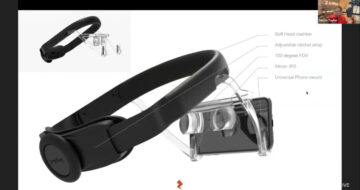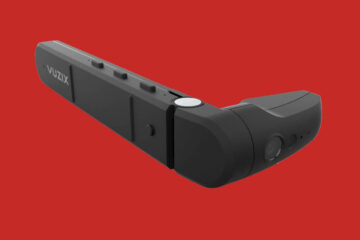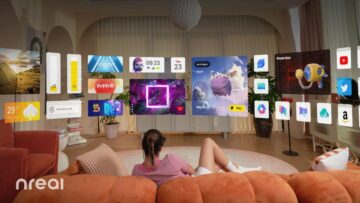
EyeWay Vision has just recently joined the LaSAR Alliance. If that news doesn’t thrill you, it could be because EyeWay and the LaSAR Alliance are both brand new. However, they have both recently come together in an exciting example of technology innovation and collaboration in XR research.
Meet EyeWay Vision
EyeWay Vision isn’t actually brand new. They’ve been “flying under the radar” for the last seven years doing early-stage research and development in Israel.
Specifically, the company is exploring the far future of AR through eye-tracking laser scanning, and “foveated projection.” Essentially, they want to project digital images onto the eye rather than onto a lens in front of the eye. This involves understanding where the eye is looking and what already exists there in the physical world.
Dr. Nikhil Balram, formerly a Google executive, was announced the head of the Silicon Valley subsidiary late last year in the release announcing the new US branch.
“What if you actually just projected an image the size of the pupil?” Dr. Balram asked in a remote interview with ARPost. “Now you can have very low power devices and very high-resolution images.”
Power use is a target of XR technology innovation in part because, as David McIntyre of Perceive told ARPost in an interview around the time that EyeWay came to the US, “when you start adding processing, heat becomes a problem.” In AR devices without an external compute box, that often means heat discomfort or danger directly on the user’s head or face.
Meet the LaSAR Alliance
The LaSAR Alliance (“LaSAR” is short for “Laser Scanning for Augmented Reality”), like EyeWay, is only sort of new. The alliance itself is the newest edition to IEEE’s Industry Standards and Technology Organization, which has been driving technology innovation for over 20 years.
“The alliance was created to foster a platform and ecosystem of like-minded companies for the growth and development of laser and AR markets in general,” LaSAR Alliance Chair, Bharath Rajagopalan, said in the interview. “We want to have the best-of-breed solutions. We want to encourage, as much as possible, a wide variety of different approaches.”
Essentially, member companies get access to an exclusive network of organizations interested in solving similar problems. Companies interact with each other through alliance initiatives, but also have the freedom to collaborate, network, and form partnerships on their own outside of the alliance. In exchange, member organizations contribute to documents like best-practice guides.
In addition to creating a “marketplace of ideas,” Rajagopalan hopes that LaSAR Alliance member organizations will achieve “harmonization rather than standardization” of industry practices through their shared technology innovations.
Balancing Collaboration…
So, why has a company that’s been essentially in hiding for over half a decade suddenly joined a technology innovation alliance? Because no one can operate in a vacuum.
According to Dr. Balram, EyeWay’s vision for the future of AR involves a “network of components that come together” and that includes components outside of EyeWay’s core competency areas.
“We see ourselves as a systems company… we developed this technology and now we need to start working with the ecosystem,” said Dr. Balram. “The Silicon Valley company is really geared outward.”
This is exactly the kind of attitude that Rajagopalan hopes that all member organizations bring to the table. He also encourages technology innovation companies that aren’t directly involved in laser scanning AR technologies but also companies “building things around it” to get involved. This way, LaSAR Alliance can represent “the entire rich ecosystem.”
Other early entrants to the Alliance include companies making micromirrors. These mirrors are not directly involved in laser scanning but are involved in XR displays including the lensless headsets of the future proposed by XR pioneer Doug Magyari.
…and Competition
Both Dr. Balram and Rajagopalan touched on the concept of competition, which is bound to come up with the topic of collaborative technology innovation. Neither of them thinks that it is an obstacle to participation in the alliance.
“You can have competition and collaboration; they can both exist,” said Rajagopalan. “A rising tide lifts all boats.”
Dr. Balram also expressed confidence not just because there are different markets and use cases for different kinds of displays that make room in the market. He also expressed confidence in the unique nature and quality of EyeWay.
“If you create an experience that’s 10x, no one will ever go back. It’s like going from black-and-white TV to color,” said Dr. Balram. “That’s what inspired me to leave Google to come to this little startup. This is the direction AR is going and we’ll never go back.”
Driving Technology Innovation in XR
While there are a few companies in the XR space offering “end-to-end solutions”, most remain “systems companies” like EyeWay.
When these systems companies come together in organizations like the LaSAR Alliance, technology innovation takes off in ways that are both explosive and sustainable – independent and integrated. These innovations are no less significant than the strictly siloed competitive feature races that we so often see in this rapidly changing XR space.
Source: https://arpost.co/2021/04/23/eyeway-technology-innovation-lasar-alliance/
- 5G
- access
- active
- Alliance
- announced
- AR
- around
- Augmented Reality
- border
- Box
- Campaign
- cases
- collaboration
- Companies
- company
- competition
- Compute
- confidence
- continues
- Creating
- Customers
- Development
- Devices
- digital
- documents
- driving
- Early
- ecosystem
- exchange
- Exclusive
- executive
- eye
- Face
- Feature
- form
- Freedom
- future
- General
- Growth
- Guides
- head
- HTTPS
- image
- Including
- industry
- industry standards
- Innovation
- Interview
- involved
- Israel
- IT
- laser
- Making
- Market
- Markets
- network
- news
- Newsletter
- offering
- Other
- partnerships
- platform
- power
- project
- quality
- Reality
- research
- research and development
- scanning
- shared
- Short
- Silicon Valley
- Size
- So
- Solutions
- Space
- standards
- start
- startup
- sustainable
- Systems
- Target
- tech
- Technologies
- Technology
- The Future
- Tide
- time
- tv
- us
- Vacuum
- Virtual
- Virtual reality
- vision
- world
- XR
- year
- years










